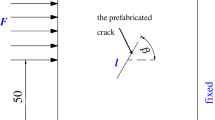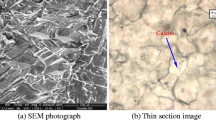Abstract
Rock reinforcement systems, such as resin-grouted rock bolts, display complex creep behavior because both grouting materials and bolts show time-dependent behavior. In this paper, only the time-dependent behavior of grouting material was investigated, in which creep tests of grouting material was conducted in triaxial compression apparatus at room temperature. The test specimens were provided from the Araldite epoxy resin used in rock reinforcement. We attempt to predict long-term creep parameter using triaxial creep tests and to define time-dependent characteristics of the bounding material. In short-term creep tests, three different axial and confining stress levels were applied in steps to each specimen. The transient creep for all the stress levels were described by power function which fit properly to time–strain curves. The maximum difference between the proposed model and experimental long-term creep strain was less than 7.1 %. It was observed that the creep rate of a grouting material specimen directly depends on the deviator of stress (i.e., σ1–σ3).



Similar content being viewed by others
References
ASTM D 4543 (Reapproved 1991) Standard practices for preparing rock core specimens and determining dimensional and shape tolerances. Annual book of ASTM standards, Section 4, construction, Soil and Rock , Building Stones, Conshohocken, PA: American Society for testing and Materials, Vol. 04.08
Atkinson BK (1975) Experimental deformation of polycrystalline pyrite: effects of temperature, confining pressure, strain rate, and porosity. Economic Geology 70:473–487
Boidy E, Bouvard A, Pellet F (2002) Back analysis of time-dependent behavior of a test gallery in claystone. Tunn Undergr Sp Tech 17:415–425
Jo BW, Ta GH, Chang HK (2007) Uniaxial creep behavior and recycled-PET polymer concrete. Constr Build Mater 21:1552–1559
Barla G (2001) Tunneling under squeezing conditions. In: Tunneling Mechanics, Eurosummerschool, Innsbruck., pp 169–268
Buavari S (1982) Fundamental principles of solid mechanics. L HL&H Mining Timber: 30–55
Celtite catalogue, Australian manufacturer of strata control products for supply to the mining, civil engineering and tunneling industries.
Cruden DM (1971) The form of the creep law for rock under uniaxial compression. Int J Rock Mech Min Sci. 11:129–156
Charalambous K) 1991) Accelerated compression and flexural creep testing of polymer concrete. PH.D Dissertation, University of Texas at Austin
Chen T (2000) Determining a Prony Series for a viscoelastic material from time varying strain data. U.S. Army Research Laboratory, Hampton
Dusseault MB, Fordham CJ (1993) Time-dependent behavior of rocks. In: Hudson JA (ed) Comprehensive rock engineering, principles, practice and project, 3rd edn. Pergamon Press, Oxford, pp 119–149
Ghorbani M, Sharifzadeh M (2009) Long-term stability assessment of Siah Bisheh powerhouse cavern based on displacement back analysis method. Tunn Undergr Sp Tech 24:574–583
Hobst L, Zajíc J (1983) Anchoring in rock and soil. Developments in geotechnical engineering, 2nd edn. Elsevier, New York. ISBN 0444600779
Heap M, Baud P, Meredith P (2008) The influence of effective stress and pore fluid pressure on brittle creep in water-saturated darley dale sandstone. Geophysical Research Abstracts 10, EGU2008-A-00263
Jaeger JC, Cook NGW (1979) Fundamental of rock mechanics, 3rd edn. Chapman & Hall, London, pp 79–311
Kranz RL (1980) The effects of confining pressure and stress difference on static fatigue of granite. Journal of Geophysical Research: Solid Earth 85(B4):1854–1866. doi:10.1029/JB085iB04p01854
LeComte P (1965) Creep in rock salt. J Geol 73:469–484
Lockner D, Byerlee J (1977) Acoustic emission and creep in rock at high confining pressure and differential stress. Bull Seismol Soc Am 67(2):247–258
Lama RD, Vutukuri VS (1978) Handbook on Mechanical Properties of Rocks, 2nd edn. Trans Tech Publications, Clausthal
Mollamahmutoglu M (1999) Effect of incremental loading on the creep behavior of chemically grouted sand. Bull Eng Geol Environ 57:353–358
Nadimi S, Shahriar K, Sharifzadeh M, Moarefvand P (2010) Triaxial creep tests and back analysis of time-dependent behavior of Siah-Bisheh cavern by 3-dimensional distinct element method. Tunn Undergr Sp Tech. 26(1):155–162
OilAir Hydraulics Inc. catalogue (1996) Accumulator Training Manual, October
Ping X, Xilun X (1996) Experimental study on creep characteristics of granite of the TGP. Chin. J. Geotech. Eng. 8(4):63–67
Soleiman DM, Shahriar K, Moarefvand P, Gharouninik M (2011) Application of the strain energy to estimate the rock load in squeezing ground condition of Eamzade Hashem tunnel in Iran. AJGS Journal. doi:10.1007/s12517-011-0117-1
Zarei H, Sharifzadeh M (2010) Identifying geological hazard related to tunneling in carbonate karstic rocks - Zagros. Iran AJGS Journal doi:10.1007/s12517-010-0218-y
Wawersik WR, Zimmerer DJ (1994) Triaxial creep measurement on rock salt from the jennings dome, Louisiana, borehole LA, core #8. Geomechanics department 6117, Sandia National Laboratories, Albuquerque. doi:10.2172/10181963
Yongsheng Z, Changrong H (2005) An experimental study of quartz-coesite transition at differential stress. Chin Sci Bull 50:446–451
Zhang LQ, Yue ZQ, Yang ZF, Qi JX, Liu FC (2006) A displacement-based back analysis method for rock mass modulus and horizontal in situ stress in tunneling—illustrated with a case study. Tunn Undergr Sp Tech. 21(6):639–649
Acknowledgment
The writers gratefully acknowledge the test facilities and measurement data for this work, which was supported by the School of Mining Engineering and the Mining Research Center of University of New South Wales, Sydney, Australia. The authors would like to thank Prof. J. Galvin, Prof. B. Hebel White, and Dr. B. Lin for their assistance and providing valuable data.
Author information
Authors and Affiliations
Corresponding author
Rights and permissions
About this article
Cite this article
Nadimi, S., Shahriar, K. Experimental creep tests and prediction of long-term creep behavior of grouting material. Arab J Geosci 7, 3251–3257 (2014). https://doi.org/10.1007/s12517-013-0920-7
Received:
Accepted:
Published:
Issue Date:
DOI: https://doi.org/10.1007/s12517-013-0920-7




